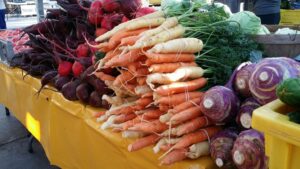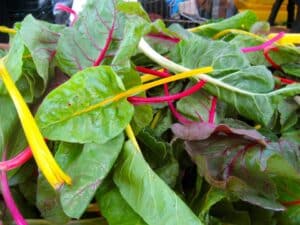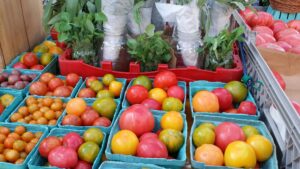
Having been selling to customers at farmers markets since 1994, we’ve noticed some things about shopping habits. Some folks come to the farmers market with list in hand in an effort to get as much as they can at the farmers market before they head to a grocery store to round-out their dinner plans; others start crafting menus in their heads as they explore the week’s offerings.
There are those people who have wildly elaborate recipes with all sorts of ingredients and lots of prep, while others have learned to let the produce speak for itself, and simply steam or grill and eat, with maybe some salt, pepper and butter.
Some customers like to take in a bird’s-eye view of the entire market to get a sense of what is being offered, maybe get a cup of coffee and a breakfast sandwich and chat with friends as they stroll. This is a great way to inform your thoughts on what to purchase.
There are also those customers who know that some prize finds will be gone if they lollygag about too long, so they make strategic surgical strikes, securing delectable seasonal treats. It is hard to watch when someone finds out a key item on their list is not available; they kinda shudder, then look up to be sure we are sure, then give the rest of the list a long look as if the list has no meaning any more. Some curse audibly.
No matter which type of market customer you are, we would like to share some tips on how to eat seasonally and shop the farmers market with style.

Also learn about using different cuts of meat. You’ll find a slow-cooked chuck roast or smoked brisket is just as tender as filet mignon, and it’s much more affordable. Cook a whole chicken and get several meals out of it, rather than selecting the boneless, skinless breast meat.

The single biggest mistake we see people make is they get hung up on scoring a certain variety of an item. Silver Queen sweet corn is the most common, but it happens with tomatoes often, as well. Usually these people approach the table with a somewhat desperate look—if not frantic. “Do you have Silver Queen?” they blurt out, often over other customers. We politely say, “No, sir,” but they usually don’t stick around long enough to hear that we have a nice, super-sweet corn variety that we grow instead. The short of it is, yes, Silver Queen was far and away better than common sweet corn back before the days of cell phones, men walking on the moon or the Internet. There is a whole biological process behind why Silver Queen was the ideal corn, and newer varieties have been bred to account for this while keeping a wonderfully sweet flavor and tender kernel. (Ask me about it at market—it’s much too long to write about here.) When the frantic customer exits the market empty-handed in disgust, I resist the urge to holler out, “We did not drive a Model T to the market!”
Do the vegetables look fresh and clean? Are they neatly arranged, easy to identify, clearly priced? Look at how the produce was transported or packaged awaiting display.
Is the vendor attentive and eager to assist you, seemingly proud of the products? Is someone at the booth knowledgeable about the items and how to prepare them?
If you read last week’s newsletter, you know all about the labels that can be put on foods. One of the reasons we migrated to organic production is that there is no good way to spin the tale that highly toxic synthetic sprays were applied directly on the food you are about to consume. As we were transitioning crops to meet the organic certification standards, we had a regular customer who would ask “What do you have that’s organic?”, which is what he would buy. These are words to live by.
Ask when it was picked, and whether it was rinsed and cooled. Some things—like beans, peas and okra—should never be washed until ready to prepare, but do need to be chilled. Tomatoes get hand wiped but never chilled. All this effort is what allows the produce to last several days after you purchase it. Without this effort, the produce has a very short shelf life.

As friends of Elmwood Stock Farm, we want you to exhibit good farmers market shopping etiquette to all of the vendors. (I will try to not rant on about this, but I might a little.)
Shopping the farmers market is a great way to revel in food. Try new foods, new recipes. Don’t hem and haw for five minutes on whether to try a head of napa cabbage—buy it and try it! We are always willing to educate our customers about the difference between our varieties and the ones they may see in the supermarkets. We enjoy sharing and learning new cooking techniques with our customers. We suggest you start with the organic offerings, then look at freshness and quality, then variety, then price.
We are proud of the wholesome, certified organic, appropriately rinsed and cooled produce we take to town. We want you to enjoy it, too, so please, do not only shop for taste, but also with it. —Mac Stone



Made with 
